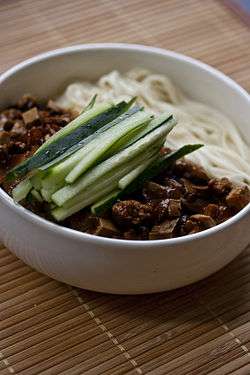Zhajiangmian
 | |
| Type | Chinese noodles |
|---|---|
| Place of origin | China |
| Main ingredients | Cumian, ground pork, zhajiang (fermented soybean paste) |
|
| |
| Zhajiangmian | |||||||||
| Chinese name | |||||||||
|---|---|---|---|---|---|---|---|---|---|
| Traditional Chinese | 炸醬麵 | ||||||||
| Simplified Chinese | 炸酱面 | ||||||||
| |||||||||
| Korean name | |||||||||
| Hangul | 자장면/짜장면 | ||||||||
| Japanese name | |||||||||
| Kanji | 炸醤麺 | ||||||||
| Kana | ジャージャー麺 | ||||||||
Zhajiangmian (Traditional Chinese:炸醬麵, Simplified Chinese:炸酱面. Literally "fried sauce noodles"), also noodles in soybean paste, is a Chinese dish consisting of thick wheat noodles topped with zhajiang sauce (炸醬). Zhajiang sauce is normally made by simmering stir-fried ground pork or beef with salty fermented soybean paste.
In Beijing cuisine, yellow soybean paste (黄酱) is used, while in Tianjin and other parts of China sweet bean sauce (甜面酱), hoisin sauce (海鲜酱), or broad (fava) bean sauce (豆瓣酱) may be used in place of the yellow soybean paste. Soy sauce can also be used instead of the soybean paste. Zhajiang (Simplified Chinese: 炸酱) sauce also means fried sauce in Chinese. Although the sauce itself is made by stir-frying, this homonym does not carry over into the Traditional Chinese term, which describes the actual bean paste.
A vegetarian version of zhajiang sauce may be made by substituting ground beef or pork with finely diced extra firm smoked tofu (熏豆腐干), edamame (黄豆), or extra firm tofu (素鸡). Lacto-ovo vegetarian versions may use chopped omelette alongside or in lieu of extra firm tofu or edamame.
The vegetarian versions generally call for soybean paste of any sort instead of soy sauce, since the tofu chunks are larger and need more structure. Low-fat dieters often use ground, skinless chicken for the meat portion since ground turkey is not very popular in Asia, and a halal version is often made with ground beef or lamb.
See also
| Wikimedia Commons has media related to Zha jiang mian. |